History

 Today’s solar eclipse will not be the first one I have ever seen, but it will be the first total solar eclipse I have ever seen. I most clearly recall the July 10, 1972 eclipse. It was a warm sunny day, and downtown Casper, Wyoming had set up a viewing telescope for those who wanted to have a look. Casper was not in the path of totality, so crowds were not an issue like they are this time. I find myself somewhat stunned that Casper is one of the best sites to view today’s eclipse. Casper isn’t usually a big tourist attraction, but today, we have found ourselves at the center of all the hoopla.
Today’s solar eclipse will not be the first one I have ever seen, but it will be the first total solar eclipse I have ever seen. I most clearly recall the July 10, 1972 eclipse. It was a warm sunny day, and downtown Casper, Wyoming had set up a viewing telescope for those who wanted to have a look. Casper was not in the path of totality, so crowds were not an issue like they are this time. I find myself somewhat stunned that Casper is one of the best sites to view today’s eclipse. Casper isn’t usually a big tourist attraction, but today, we have found ourselves at the center of all the hoopla.
I’ve watched a movie about viewing a total eclipse, and people come away feeling…somehow changed after viewing one. My mind can’t seem to wrap itself around how that could happen, but I guess I’ll see how I feel afterward. For me, I think that if I feel a change it will be more because I think that the signs of the sky were placed there by God, to speak to His people. Many people may think that’s crazy, but it’s no more strange than to think that it’s accidental. The whole universe was created by God, so why wouldn’t He plan it’s every move.

So, the eclipse is over now, and I must say that the moments in totality were…amazing. The color of the atmosphere around us was not like the typical, dusk that everyone said to expect. It was different than that somehow. My son-in-law, Kevin Petersen thought so too. While we were waiting for totality, I tried to look at the things everyone said to watch for, and probably the most surprising to me was the eclipse shadows. I don’t know what I thought it would look like, but when I saw it, I startled my daughter, Corrie Petersen; my son-in-law, Kevin; and my husband, Bob Schulenberg. I shouted, “Look!! It’s the eclipse shadows!!” They are actually called Solar Eclipse Crescent Shadows. Well, my family thought I saw a snake or something, hahaha!! We also noticed, as expected, that the birds started their evening song ritual, preparing to go to sleep for the night. We might have heard crickets, but the people around us set off fireworks at that time, so we couldn’t hear that. We saw the sunset along the horizon, and afterward we had to laugh, because we all forgot to look for the stars. I caught a very faint glimpse of them in a picture I took.


Totality was an amazing experience, but I like most people think that 2 minutes and 26 seconds is a very short time. You simply don’t have time to see everything that there was to see. The cool air was, in reality, a welcome change from the heat we had been sitting in, but like the rest of the eclipse, it didn’t last very long. With the return of the sun, came the warmth of the sun again. Totality was over, and yes, maybe I was changed. I had experienced a total eclipse, and it was amazing. It was something I will never forget.
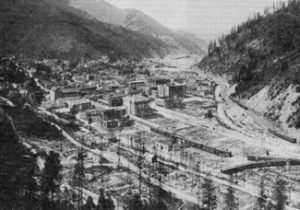
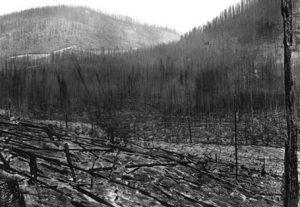 With summer, and especially late summer, when things are beginning to dry up, comes an increased danger of wildfires. Add to that, an extremely dry spring and early summer, and you have a recipe for disaster. Such was the case in northwest Washington, northern Idaho, and western Montana in 1910. There were a great number of problems that contributed to an over active fire season, and ultimately, the destruction that began on August 20, 1910, quickly became a firestorm that burned about three million acres…a full 4,700 square miles before it was over. The areas burned included parts of the Bitterroot, Cabinet, Clearwater, Coeur d’Alene, Flathead, Kaniksu, Kootenai, Lewis and Clark, Lolo, and Saint Joe National Forests. The extensive burned area was approximately the size of the state of Connecticut. The extreme scorching heat of the sudden blowup can be attributed to the great Western White Pine forests that blanketed Idaho. The hydrocarbons in the resinous sap boiled out and created a cloud of highly flammable gas that blanketed hundreds of square miles, which then spontaneously detonated dozens of times, each time sending tongues of flame thousands of feet into the sky, and creating a rolling wave of fire that destroyed anything and everything in its path.
With summer, and especially late summer, when things are beginning to dry up, comes an increased danger of wildfires. Add to that, an extremely dry spring and early summer, and you have a recipe for disaster. Such was the case in northwest Washington, northern Idaho, and western Montana in 1910. There were a great number of problems that contributed to an over active fire season, and ultimately, the destruction that began on August 20, 1910, quickly became a firestorm that burned about three million acres…a full 4,700 square miles before it was over. The areas burned included parts of the Bitterroot, Cabinet, Clearwater, Coeur d’Alene, Flathead, Kaniksu, Kootenai, Lewis and Clark, Lolo, and Saint Joe National Forests. The extensive burned area was approximately the size of the state of Connecticut. The extreme scorching heat of the sudden blowup can be attributed to the great Western White Pine forests that blanketed Idaho. The hydrocarbons in the resinous sap boiled out and created a cloud of highly flammable gas that blanketed hundreds of square miles, which then spontaneously detonated dozens of times, each time sending tongues of flame thousands of feet into the sky, and creating a rolling wave of fire that destroyed anything and everything in its path.
That summer had been described as “like no others.” The drought resulted in forests that were filled with dry fuel, which had previously grown up on abundant autumn and winter moisture. Fires were set by hot cinders flung from locomotives, sparks, lightning, and backfiring crews, and by mid-August, there were 1,000 to 3,000 fires burning in Idaho, Montana, Washington, and British Columbia. Then on August 20th, everything blew up into a firestorm. The firestorm burned over two days, August 20 and 21. It killed 87 people, most of them firefighters. The entire 28 man “Lost Crew” was overcome by flames and perished on Setzer Creek in Idaho outside of Avery. The Great Fire of 1910 is believed to be the largest, although not the deadliest, forest fire in United States history. It was commonly referred to as the Big Blowup, the Big Burn, or the Devil’s Broom fire. Smoke from the fire could be seen as far east as Watertown, New York, and as far south as Denver, Colorado. It was reported that at night, five hundred miles out into the Pacific Ocean, ships could not navigate by the stars because the sky was cloudy with smoke.
The fire actually started as many small fires. Then, on August 20, a cold front blew in and brought hurricane-force winds. The wind whipped the hundreds of small fires into one or two blazing infernos. The larger fires were impossible to fight. They simply didn’t have the manpower, or the supplies. The United States Forest Service…then called the National Forest Service…was only five years old at the time and unprepared for the possibilities of this dry summer. Later, at the urging of President William Howard Taft, the United States Army, 25th Infantry Regiment…known as the Buffalo Soldiers, was brought in to help fight the blaze. The most famous story of survival was that of Ed Pulaski, a United States Forest Service ranger who led a large group of his men to safety in an abandoned prospect mine outside of Wallace, Idaho, just as they were about to be overtaken by the fire. Pulaski fought off the flames at the mouth of the shaft until he passed out like the other men. Around midnight, one man said that he was getting out of there. Knowing that they would have no 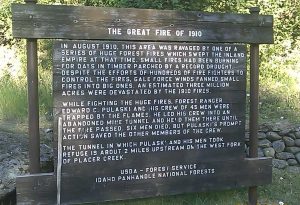
 chance of survival if they ran, Pulaski drew his pistol. He threatened to shoot the first person who tried to leave. In the end, all but five of the forty or so men survived. Several towns were completely destroyed by the fire. The fire was finally extinguished when another cold front swept in, bringing with it, steady rain. Unfortunately, it was too late for the 87 people who lost their lives in the blaze. Memorials were placed in several of the fire areas.
chance of survival if they ran, Pulaski drew his pistol. He threatened to shoot the first person who tried to leave. In the end, all but five of the forty or so men survived. Several towns were completely destroyed by the fire. The fire was finally extinguished when another cold front swept in, bringing with it, steady rain. Unfortunately, it was too late for the 87 people who lost their lives in the blaze. Memorials were placed in several of the fire areas.

 After the Revolutionary War, and the United States independence that followed, the relationship between the two nations was quite strained. The United States did not like having British military posts on our northern and western borders, and Britain’s violation of American neutrality in 1794 when the Royal Navy seized American ships in the West Indies during England’s war with France. Finally, in an attempt to smooth things over, Supreme Court Chief Justice John Jay, who was appointed by President Washington, came up with a treaty. The treaty officially known as the “Treaty of Amity Commerce and Navigation, between His Britannic Majesty; and The United States of America” was signed by Britain’s King George III on November 19, 1794 in London. However, after Jay returned home with news of the treaty’s signing, President Washington, who was now in his second term, had encountered fierce Congressional opposition to the treaty. By 1795, its ratification was still uncertain, and there was work to be done to change things.
After the Revolutionary War, and the United States independence that followed, the relationship between the two nations was quite strained. The United States did not like having British military posts on our northern and western borders, and Britain’s violation of American neutrality in 1794 when the Royal Navy seized American ships in the West Indies during England’s war with France. Finally, in an attempt to smooth things over, Supreme Court Chief Justice John Jay, who was appointed by President Washington, came up with a treaty. The treaty officially known as the “Treaty of Amity Commerce and Navigation, between His Britannic Majesty; and The United States of America” was signed by Britain’s King George III on November 19, 1794 in London. However, after Jay returned home with news of the treaty’s signing, President Washington, who was now in his second term, had encountered fierce Congressional opposition to the treaty. By 1795, its ratification was still uncertain, and there was work to be done to change things.
The two biggest opponents to the treaty were two future presidents…Thomas Jefferson and James Madison. Jefferson was, at the time, in between political positions. He had just completed a term as Washington’s secretary of state from 1789 to 1793 and had not yet become John Adams’ vice president. Fellow Virginian, James Madison was a member of the House of Representatives. Jefferson, Madison and other opponents feared the treaty gave too many concessions to the British. They argued that Jay’s negotiations actually weakened American trade rights and complained that it committed the United States to paying pre-revolutionary debts to English merchants. Washington himself was not completely satisfied with the treaty, but considered preventing another war with America’s former colonial master a priority.
The treaty was finally approved by Congress on August 14, 1795, with exactly the two-thirds majority it needed 
 to pass. President Washington signed the treaty just four days later, on August 18, 1795. Washington and Jay may have won the legislative battle and averted war temporarily, but it created a conflict at home that highlighted a deepening division between those of different political ideologies in Washington DC, much like what we see these days. Jefferson and Madison mistrusted Washington’s attachment to maintaining friendly relations with England over revolutionary France, who would have welcomed the United States as a partner in an expanded war against England.
to pass. President Washington signed the treaty just four days later, on August 18, 1795. Washington and Jay may have won the legislative battle and averted war temporarily, but it created a conflict at home that highlighted a deepening division between those of different political ideologies in Washington DC, much like what we see these days. Jefferson and Madison mistrusted Washington’s attachment to maintaining friendly relations with England over revolutionary France, who would have welcomed the United States as a partner in an expanded war against England.
 As the pioneers headed west, there were various disputes over ownership of the lands they were settling into. The Native American people did not think that they should have to surrender their lands to the White Man, but it seemed that they had no choice. Still, there were some Native Americans who refused to be pushed around by the government. On August 17, 1862, violence erupted in Minnesota as desperate Dakota Indians attacked white settlements along the Minnesota River. This was a fight that the Dakota Indians would eventually lose. They were no match for the US military, and six weeks later, it was over.
As the pioneers headed west, there were various disputes over ownership of the lands they were settling into. The Native American people did not think that they should have to surrender their lands to the White Man, but it seemed that they had no choice. Still, there were some Native Americans who refused to be pushed around by the government. On August 17, 1862, violence erupted in Minnesota as desperate Dakota Indians attacked white settlements along the Minnesota River. This was a fight that the Dakota Indians would eventually lose. They were no match for the US military, and six weeks later, it was over.
The Dakota Indians were often referred to as the Sioux, which I did not know was a derogatory name derived from part of a French word meaning “little snake.” It almost makes it seem like they were talking badly about them to their face, but so they couldn’t understand it. The government treated the Dakota poorly, and the Dakota saw their hunting lands dwindling 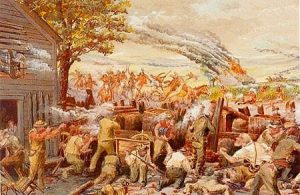 down, and apparently the provisions that the government promised to supply, rarely arrived. And now, to top it off, a wave of white settlers surrounded them too. To make matters worse, the summer of 1862 had been a harsh one, and cutworms had destroyed much of the crops. The Dakota were starving.
down, and apparently the provisions that the government promised to supply, rarely arrived. And now, to top it off, a wave of white settlers surrounded them too. To make matters worse, the summer of 1862 had been a harsh one, and cutworms had destroyed much of the crops. The Dakota were starving.
On August 17, the situation exploded when four young Dakota warriors returning from an unsuccessful hunt, stopped to steal some eggs from a white settlement. The were caught and they picked a fight with the hen’s owner. The encounter turned tragic when the Dakotas killed five members of the family. Now, the Dakota knew that they would be attacked. Dakota leaders, knew that war was at hand, so they seized the initiative. Led by Taoyateduta, also known as Little Crow, the Dakota attacked local agencies and the settlement of New 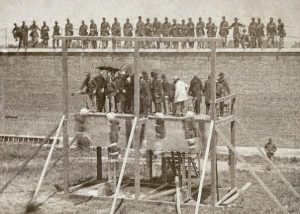 Ulm. Over 500 white settlers lost their lives along with about 150 Dakota warriors.
Ulm. Over 500 white settlers lost their lives along with about 150 Dakota warriors.
President Abraham Lincoln dispatched General John Pope, fresh from his defeat at the Second Battle of Bull Run, Virginia. Pope was to organize the Military Department of the Northwest. Some of the Dakota immediately fled Minnesota for North Dakota, but more than 2,000 were rounded up and over 300 warriors were sentenced to death. President Lincoln commuted most of their sentences, but on December 26, 1862, 38 Dakota men were executed at Mankato, Minnesota. It was the largest mass execution in American history, and it was all because they were starving, and had no hope of living through that year.

 Most of my friends know that I love shoes. In fact, that is truly an understatement. I have shoes for every need and for every outfit. I have hiking shoes, sandals, shoes for jeans, boots…lots of boots, and of course, heels…of every color, height, and style from low heels to platform heels, and even funky heels. Yes, I love shoes. But there is a line that even I won’t cross.
Most of my friends know that I love shoes. In fact, that is truly an understatement. I have shoes for every need and for every outfit. I have hiking shoes, sandals, shoes for jeans, boots…lots of boots, and of course, heels…of every color, height, and style from low heels to platform heels, and even funky heels. Yes, I love shoes. But there is a line that even I won’t cross.
Over the centuries in many areas of the world, shoe style was really a show of status. And in some countries, the size of a woman’s foot was so important that women would stuff their feet into shoes that would fit a young child. Those women were so intent on making their feet small, that they would perform a procedure on them called foot binding. It is a crazy way of tying the toes in such a way, so as to make a point of the front of the foot. The foot was then bent almost in half to fit in a shoe for a young child. I think every woman would like her feet to be smaller, at least every woman who wears size seven or above, but foot binding is extreme.
I love platform heels, but some styles…both old and new, are ridiculous. When the platform is so high, and 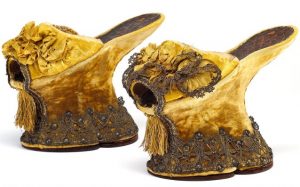

 made of something with no give to it, or has no heel on it, the woman wearing the heel really can’t even walk by themselves. And believe me, I would need help too, and I’m used to platforms. It’s just that these aren’t platforms. No, they are stilts!! Platforms have been a tradition for a very long time in Europe, clear back to the 17th century, and then they were out of fashion until the 20th century. Really, it wasn’t until Ferragamo reintroduced them in the 1930s that platforms came back in style. In 2009, an exhibition was organized, with an accompanying catalog on the topic of these elevating shoes, titled “On A Pedestal: From Renaissance Chopines to Baroque Heels.” Chopines, which were also known as zoccoli or pianelle, are a platform shoe up to 20 inches high. Of course, those who wore them required the help of servants so that they didn’t fall flat on their face…in the name of fashion. The idea of chopines, besides being a fashion statement, was to protect the wearer’s clothes from street mud. Never mind the servant’s clothes, and really, why did they have to go out in the
made of something with no give to it, or has no heel on it, the woman wearing the heel really can’t even walk by themselves. And believe me, I would need help too, and I’m used to platforms. It’s just that these aren’t platforms. No, they are stilts!! Platforms have been a tradition for a very long time in Europe, clear back to the 17th century, and then they were out of fashion until the 20th century. Really, it wasn’t until Ferragamo reintroduced them in the 1930s that platforms came back in style. In 2009, an exhibition was organized, with an accompanying catalog on the topic of these elevating shoes, titled “On A Pedestal: From Renaissance Chopines to Baroque Heels.” Chopines, which were also known as zoccoli or pianelle, are a platform shoe up to 20 inches high. Of course, those who wore them required the help of servants so that they didn’t fall flat on their face…in the name of fashion. The idea of chopines, besides being a fashion statement, was to protect the wearer’s clothes from street mud. Never mind the servant’s clothes, and really, why did they have to go out in the 
 mud anyway? They were aristocrats, couldn’t someone just carry them on a platform chair, or run their errand for them. Whatever the case may be, I will not be buying a pair of these crazy stilt platforms, should they ever come into style again.
mud anyway? They were aristocrats, couldn’t someone just carry them on a platform chair, or run their errand for them. Whatever the case may be, I will not be buying a pair of these crazy stilt platforms, should they ever come into style again.
I do love my many styles of shoes, and my platforms are among the favorites, but I draw the line at about a 3 inch platform. Much more than that, and I not only have difficulty walking, but I end up taller than everyone around me, and for me that is just too odd. I am used to being one of the “wee ones,” as my niece Kellie Hadlock calls me, and that’s ok with me. I never wanted to be tall anyway. I’ll let my platforms make me look tall. I’m good with that!!
 Everyone knows that President Lincoln was assassinated on Good Friday, April 14, 1865, while attending the play Our American Cousin at Ford’s Theatre in Washington, DC, as the Civil War was drawing to a close, but what you may not know is that this was not the first attempt on Abraham Lincoln’s life. The first attempt came one August night in 1864, just under a year before the successful attempt by John Wilkes Booth. It is unknown who the would-be assassin was in that earlier attempt, just that they very nearly succeeded.
Everyone knows that President Lincoln was assassinated on Good Friday, April 14, 1865, while attending the play Our American Cousin at Ford’s Theatre in Washington, DC, as the Civil War was drawing to a close, but what you may not know is that this was not the first attempt on Abraham Lincoln’s life. The first attempt came one August night in 1864, just under a year before the successful attempt by John Wilkes Booth. It is unknown who the would-be assassin was in that earlier attempt, just that they very nearly succeeded.
President Lincoln and his family often stayed at the Soldiers’ Home during the summer months due to the unbearable heat at the White House. President Lincoln often made the 4 mile trip from the White House to the Soldiers’ Home alone, and often late at night, an unheard of situation these days, with the secret service officers always shadowing the presidents, vice-presidents, and their families. As Lincoln was riding along that night, a shot rang out. Private John W Nichols, who was stationed at the Soldiers’ Home, rushed to the aid of the president, whom he found well, but missing his hat. President Lincoln told the private that the horse jerked upon hearing the gunshot, and his hat went flying. The private went to retrieve the hat for the president, and went he 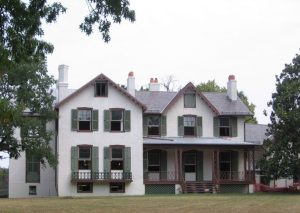 examined it, he found that it now had a bullet hole in it. It was an extremely close call, but President Lincoln requested that the matter be kept quiet, and Private Nichols didn’t tell the story until 1867. His tall hat had saved his life by causing the would be assassin to aim too high to hit his head.
examined it, he found that it now had a bullet hole in it. It was an extremely close call, but President Lincoln requested that the matter be kept quiet, and Private Nichols didn’t tell the story until 1867. His tall hat had saved his life by causing the would be assassin to aim too high to hit his head.
For America, this missed shot changed history. Had Lincoln been killed on that August night…even just that much earlier would have had devastating consequences for America. Hannibal Hamlin would have become a lame duck president. Hamlin was already off the Union ticket for vice president, having been replaced by Andrew Johnson. Hamlin would have faced strong opposition, because at the time, the Radical Democracy Party…an offshoot of the Republicans…and their nominee, John Fremont, had not yet dropped from the race. The Radical Democracy Party were even more strongly opposed to slavery than Lincoln, which is what led to their formation. Had the assassin aimed a bit lower in 1864, the election in November would likely have pitted Hamlin against Fremont and McClellan, the Democratic nominee, with Johnson perhaps running on the Union ticket.
Presidential elections always rest on who can win in an election, and in this case the winner would have turned 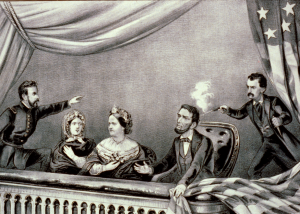 1864 America into a mess. Had the earlier would-be assassin’s shot been just a little lower, Lincoln, would have been succeeded by Hannibal Hamlin which may have given the upcoming election to Lincoln’s overly cautious former commander, General George McClellan. How either Hamlin, had he actually won re-election, or McClellan would have carried on the last year of the war, much less dealt with southern reconstruction, is a source for debate. Lincoln’s death, if combined with a lame-duck Hamlin and a conciliatory McClellan, might have encouraged the South to hold on just a while longer and resulted in an armistice rather than a victory, dramatically changing the history of America. I don’t think that anyone but Lincoln could have freed the slaves at that time.
1864 America into a mess. Had the earlier would-be assassin’s shot been just a little lower, Lincoln, would have been succeeded by Hannibal Hamlin which may have given the upcoming election to Lincoln’s overly cautious former commander, General George McClellan. How either Hamlin, had he actually won re-election, or McClellan would have carried on the last year of the war, much less dealt with southern reconstruction, is a source for debate. Lincoln’s death, if combined with a lame-duck Hamlin and a conciliatory McClellan, might have encouraged the South to hold on just a while longer and resulted in an armistice rather than a victory, dramatically changing the history of America. I don’t think that anyone but Lincoln could have freed the slaves at that time.

 When we think of train robberies, most of us think of the Old West, and bandits on horseback, riding up along side the train, and jumping on. Then, with guns pointed at everyone, they robbed the train, and left the same way they came in. In fact, I think most of us thought that the days of robbing a train were over, and maybe that played to the advantage of the outlaws, because on August 8, 1963, a group of 15 thieves and 2 key informants pulled off one of the most famous heists of all time.
When we think of train robberies, most of us think of the Old West, and bandits on horseback, riding up along side the train, and jumping on. Then, with guns pointed at everyone, they robbed the train, and left the same way they came in. In fact, I think most of us thought that the days of robbing a train were over, and maybe that played to the advantage of the outlaws, because on August 8, 1963, a group of 15 thieves and 2 key informants pulled off one of the most famous heists of all time.
The leader and mastermind behind the heist was Bruce Reynolds, who was a known burglar and armed robber. He was an avid “fan” of the Wild West railroad heists in America, so he decided to see if he could pull something like that off in England. Reynolds and 14 other men wearing ski masks and helmets held up the Royal Mail train heading between Glasgow, Scotland, and London, England. The gang used Land Rover vehicles which had been stolen in central London and marked with identical license plates in order to confuse the police. Unlike the Wild West gangs, this gang used a false red signal to get the train to stop, then hit the driver with an iron bar, seriously injuring him, in order to gain control of the train. The thieves loaded 120 mailbags filled with the equivalent of $7 million in used bank notes into their Land Rovers and sped off to their hideout, which was the Leatherslade Farm in Buckinghamshire, England, to divide their loot. The robbers had cut all the telephone lines in the vicinity, but one of the rail-men left on the train at Sears Crossing caught a passing goods train to Cheddington, where he raised the alarm at around 04:20.
As often happens, the media reports on these things, and before you know it, they are viewed as folk heroes by the public for the audacious nature of their crime and their flight from justice. The first reports of the robbery were broadcast on the VHF police radio within a few minutes and this is where the gang heard the line “A robbery has been committed and you’ll never believe it – they’ve stolen the train!” I’m sure that added to the charm felt by the public, because seriously, who but an eccentric, would steal a train. As always seems to happen, 12 of the 15 robbers were eventually captured. They received a collective 300 years in prison. One of them, a small-time hood named Ronnie Biggs, escaped from prison after just 15 months and underwent plastic surgery to change his appearance. He fled the country and eluded capture for years, finally 
 giving himself up in 2001 when he returned from Brazil voluntarily to serve the 28 years remaining in his sentence…a rather odd thing to do, considering the fact that he had successfully escaped. The two Land Rovers used in the robbery were discovered at the thieves’ hideout. A car enthusiast still owns one of them today, and considers it a collector’s item.
giving himself up in 2001 when he returned from Brazil voluntarily to serve the 28 years remaining in his sentence…a rather odd thing to do, considering the fact that he had successfully escaped. The two Land Rovers used in the robbery were discovered at the thieves’ hideout. A car enthusiast still owns one of them today, and considers it a collector’s item.
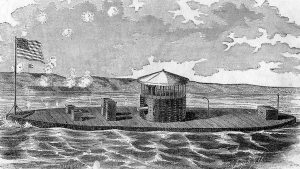 The worst fate a ship can suffer is to end up at the bottom of the sea. Nevertheless, it is a hazard that goes with the territory. Most of these lost ships simply litter the ocean floor, never seeing the light of day again, but once in a while, a ship…or part of a ship finds itself being raised up from the bottom again. Such was the case with USS Monitor, a Civil War era naval warship, that sunk to a watery grave in a storm on March 9, 1862, taking with it, 16 members of it’s crew, who were afraid to go topside in the storm.
The worst fate a ship can suffer is to end up at the bottom of the sea. Nevertheless, it is a hazard that goes with the territory. Most of these lost ships simply litter the ocean floor, never seeing the light of day again, but once in a while, a ship…or part of a ship finds itself being raised up from the bottom again. Such was the case with USS Monitor, a Civil War era naval warship, that sunk to a watery grave in a storm on March 9, 1862, taking with it, 16 members of it’s crew, who were afraid to go topside in the storm.
A short nine months before the tragedy of the USS Monitor, the ship had been part of a revolution in naval warfare. On March 9, 1862, it dueled to a standstill with the CSS Virginia in one of the most famous moments in naval history. It was the first time two ironclads ships faced each other in a naval engagement. During the battle, the two ships circled one another, jockeying for position as they fired their guns, but the cannon balls were no match for the ironclad ships, and they simply deflected off of the sides. In the early afternoon, the Virginia pulled back to Norfolk. Neither ship was seriously damaged, but the Monitor effectively ended the short reign of terror that the Confederate ironclad had brought to the Union navy. What a strange battle that must have been.
The USS Monitor was designed by Swedish engineer John Ericsson. Probably the most strange part of the design was the fact that Monitor had an unusually low profile, rising from the water only 18 inches. The ship sat so low to the water, that it could easily have resembled a submarine. The flat iron deck had a 20 foot cylindrical  turret rising from the middle of the ship. The turret housed two 11 inch Dahlgren guns. The shift had a draft of less than 11 feet so it could operate in the shallow harbors and rivers of the South. It was commissioned on February 25, 1862, and arrived at Chesapeake Bay just in time to engage the Virginia. After the famous duel with the CSS Virginia, the Monitor provided gun support on the James River for George B. McClellan’s Peninsular Campaign. By December 1862, it was clear the ship was no longer needed in Virginia, so she was sent to Beaufort, North Carolina, to join a fleet being assembled for an attack on Charleston.
turret rising from the middle of the ship. The turret housed two 11 inch Dahlgren guns. The shift had a draft of less than 11 feet so it could operate in the shallow harbors and rivers of the South. It was commissioned on February 25, 1862, and arrived at Chesapeake Bay just in time to engage the Virginia. After the famous duel with the CSS Virginia, the Monitor provided gun support on the James River for George B. McClellan’s Peninsular Campaign. By December 1862, it was clear the ship was no longer needed in Virginia, so she was sent to Beaufort, North Carolina, to join a fleet being assembled for an attack on Charleston.
The Monitor was an ideal type of ship in the sheltered waters of Chesapeake Bay, but the heavy, low-slung ship was no good in the open sea. Knowing that, the USS Rhode Island towed the ironclad around the rough waters of Cape Hatteras…a plan that would prove disastrous. As the Monitor pitched and swayed in the rough seas, the caulking around the gun turret loosened and water began to leak into the hull. More leaks developed as the journey continued. High seas tossed the craft, causing the ship’s flat armor bottom to slap the water. Each roll opened more seams, and by nightfall on December 30, it was clear that the Monitor was going to sink. That evening, the Monitor’s commander, J.P. Bankhead, signaled the Rhode Island that they needed to abandon ship. The USS Rhode Island pulled as close as safety allowed to the stricken USS Monitor, and two lifeboats were lowered to retrieve the crew. Many of the sailors were rescued, but some men were too terrified to venture onto the deck in such rough seas. The Monitor’s pumps stopped working, and the ship sank before 16 of its crew members could be rescued. It amazes me that a ship that could deflect cannon balls, was taken  down by loosened calking.
down by loosened calking.
On this day in 2002, the rusty iron gun turret of the USS Monitor rose up from the bottom of its watery grave, and into the daylight for the first time in 140 years. The ironclad warship was raised from the floor of the Atlantic, where it had rested since it went down in a storm off Cape Hatteras, North Carolina, during the Civil War. Divers had been working for six weeks to bring it to the surface. The remains of two of the 16 lost sailors were discovered by divers during the Monitor’s 2002 reemergence. Many of the ironclad’s artifacts are now on display at the Mariners’ Museum in Newport News, Virginia.
 Hitler was an insanly, evil ruler, and he hated the Jewish people…that is a known fact. It wasn’t anything they did, it was just his own twisted mind. That said, the Jewish people found themselves hiding in order to save their lives. Anne Frank was one of the most famous of those persecuted Jewish people, most likely because of her diary, which was published by her father following her death at the Bergen-Belsen concentration camp in Germany, and his release following the liberation of the camps. Annelies Marie Frank was born in Frankfurt, Germany, on June 12, 1929. She was the second daughter of Otto Frank and Edith Frank-Hollander, both of Jewish families that had lived in Germany for centuries. With the rise of Nazi leader Adolf Hitler in 1933, Otto moved his family to Amsterdam to escape the escalating Nazi persecution of Jews. In Holland, he ran a successful spice and jam business. Anne attended a Montessori school with other middle-class Dutch children, but with the German invasion of the Netherlands in 1940 she was forced to transfer to a Jewish school. In 1942, Otto began preparing a hiding place in an annex of his warehouse on the Prinsengracht Canal in Amsterdam. It was a wise move, given what was coming. The family moved in on July 15, 1942, when Anne’s sister, Margot received a letter telling her to report to the labor camps in Germany. Knowing what that meant, the family took refuge in the secret hiding place they had prepared. This would be their home for the next 25 months.
Hitler was an insanly, evil ruler, and he hated the Jewish people…that is a known fact. It wasn’t anything they did, it was just his own twisted mind. That said, the Jewish people found themselves hiding in order to save their lives. Anne Frank was one of the most famous of those persecuted Jewish people, most likely because of her diary, which was published by her father following her death at the Bergen-Belsen concentration camp in Germany, and his release following the liberation of the camps. Annelies Marie Frank was born in Frankfurt, Germany, on June 12, 1929. She was the second daughter of Otto Frank and Edith Frank-Hollander, both of Jewish families that had lived in Germany for centuries. With the rise of Nazi leader Adolf Hitler in 1933, Otto moved his family to Amsterdam to escape the escalating Nazi persecution of Jews. In Holland, he ran a successful spice and jam business. Anne attended a Montessori school with other middle-class Dutch children, but with the German invasion of the Netherlands in 1940 she was forced to transfer to a Jewish school. In 1942, Otto began preparing a hiding place in an annex of his warehouse on the Prinsengracht Canal in Amsterdam. It was a wise move, given what was coming. The family moved in on July 15, 1942, when Anne’s sister, Margot received a letter telling her to report to the labor camps in Germany. Knowing what that meant, the family took refuge in the secret hiding place they had prepared. This would be their home for the next 25 months.
Nineteen months earlier, on December 1, 1940, Anne’s father Otto Frank moved the offices of the spice and gelling companies he worked for, Opekta and Pectacon, from an address on Singel canal to Prinsengracht 263. The warehouse on Prinsengracht Canal, where Otto Frank ran his business, was a perfect place to create a safe room for his family, should the need ever arise. On July 15, 1942, the need arose. The ground floor of the building consisted of three sections. The front was the goods and dispatch entrance, basically the storefront. Behind the storefront  was the middle section where the spice mills were located. At the rear, which was the ground floor of the annex, was the warehouse where the goods were packed for distribution. On the first floor above were the offices of Frank’s employees…Miep Gies, Bep Voskuijl (known in Anne Frank’s diary as Elli) and Johannes Kleiman were in the front office. Victor Kugler in the middle and Otto Frank in the rear office above the warehouse and below the floors which would later hide him and his family for two years until their betrayal to the Nazi authorities. The Achterhuis (Dutch for “back house”) or Secret Annex…as it was called in The Diary of a Young Girl, an English translation of the diary…is the rear extension of the building. It was concealed from view by houses on all four sides of a quadrangle. Its secluded position made it an ideal hiding place for Otto Frank, his wife Edith, two daughters, Margot and Anne, and four other Jews seeking refuge from Nazi persecution. Though the total amount of floor space in the inhabited rooms came to only about 500 square feet, Anne Frank wrote in her diary that it was relatively luxurious compared to other hiding places they had heard about. Those in hiding had been so careful. The entrance to the secret annex was hidden by a hinged bookcase, and former employees of Otto and other Dutch friends delivered them food and supplies procured at high risk. Anne and the others lived in rooms with blacked-out windows, and never flushed the toilet during the day out of fear that their presence would be detected. In June 1944, Anne’s spirits were raised by the Allied landing at Normandy, and she was hopeful that the long-awaited liberation of Holland would soon begin.
was the middle section where the spice mills were located. At the rear, which was the ground floor of the annex, was the warehouse where the goods were packed for distribution. On the first floor above were the offices of Frank’s employees…Miep Gies, Bep Voskuijl (known in Anne Frank’s diary as Elli) and Johannes Kleiman were in the front office. Victor Kugler in the middle and Otto Frank in the rear office above the warehouse and below the floors which would later hide him and his family for two years until their betrayal to the Nazi authorities. The Achterhuis (Dutch for “back house”) or Secret Annex…as it was called in The Diary of a Young Girl, an English translation of the diary…is the rear extension of the building. It was concealed from view by houses on all four sides of a quadrangle. Its secluded position made it an ideal hiding place for Otto Frank, his wife Edith, two daughters, Margot and Anne, and four other Jews seeking refuge from Nazi persecution. Though the total amount of floor space in the inhabited rooms came to only about 500 square feet, Anne Frank wrote in her diary that it was relatively luxurious compared to other hiding places they had heard about. Those in hiding had been so careful. The entrance to the secret annex was hidden by a hinged bookcase, and former employees of Otto and other Dutch friends delivered them food and supplies procured at high risk. Anne and the others lived in rooms with blacked-out windows, and never flushed the toilet during the day out of fear that their presence would be detected. In June 1944, Anne’s spirits were raised by the Allied landing at Normandy, and she was hopeful that the long-awaited liberation of Holland would soon begin.
The family remained hidden here for two years and one month, praying that the war would end, and Hitler would be defeated before they were found. They stayed there until they were anonymously betrayed to the Nazi authorities by a Dutch informer, arrested, and deported to their deaths in concentration camps. Of the hidden group, only Otto Frank survived the concentration death camps. It was on this day, August 4, 1944, that time ran out for the family and friends in the secret annex. The Nazi Gestapo showed up at the warehouse,  and they knew everything they needed to know about how to find the group of Jews in the secluded hiding place. They went right to the bookcase door and charged into the secret rooms. I can only imagine the terror that followed…the screaming, the running, the fear of knowing what was probably coming next. They were sent to a concentration camp in Holland, and in September Anne and most of the others were shipped to the Auschwitz death camp in Poland. In the fall of 1944, with the Soviet liberation of Poland underway, Anne was moved with her sister Margot to the Bergen-Belsen concentration camp in Germany. Suffering under the deplorable conditions of the camp, the two sisters caught typhus and died in early March 1945. The camp was liberated by the British less than two months later. Otto Frank was the only one of the 10 to survive the Nazi death camps. Two short months…or six short months, if you look at when they were captured. What a waste of a life or lives, and all because of the insanity of one man.
and they knew everything they needed to know about how to find the group of Jews in the secluded hiding place. They went right to the bookcase door and charged into the secret rooms. I can only imagine the terror that followed…the screaming, the running, the fear of knowing what was probably coming next. They were sent to a concentration camp in Holland, and in September Anne and most of the others were shipped to the Auschwitz death camp in Poland. In the fall of 1944, with the Soviet liberation of Poland underway, Anne was moved with her sister Margot to the Bergen-Belsen concentration camp in Germany. Suffering under the deplorable conditions of the camp, the two sisters caught typhus and died in early March 1945. The camp was liberated by the British less than two months later. Otto Frank was the only one of the 10 to survive the Nazi death camps. Two short months…or six short months, if you look at when they were captured. What a waste of a life or lives, and all because of the insanity of one man.
 My co-worker is a high school student named, Amanda Ingram. Amanda is also taking a college class through the Boces program this summer. She is taking Wyoming History, and she was required to write a paper concerning the boom and bust cycle in Wyoming, using newspapers from the 19th, 20th and 21st centuries. She was given a public website to use to locate news articles for her paper. That intrigued me, and I decided to check out the site. The site allows you to look by city, county, year, or simply by all newspapers. When I went in to look, I of course, went for the oldest newspaper they had.
My co-worker is a high school student named, Amanda Ingram. Amanda is also taking a college class through the Boces program this summer. She is taking Wyoming History, and she was required to write a paper concerning the boom and bust cycle in Wyoming, using newspapers from the 19th, 20th and 21st centuries. She was given a public website to use to locate news articles for her paper. That intrigued me, and I decided to check out the site. The site allows you to look by city, county, year, or simply by all newspapers. When I went in to look, I of course, went for the oldest newspaper they had.
What I found was so exciting. That first newspaper in Wyoming was The Chugg Water Journal, out of Fort Laramie, published on October 2, 1949. For those who live in Wyoming, spelling Chugwater…Chugg Water is very strange. That made me think, mostly about what Chugwater meant anyway, and why it might be written Chugg Water for the newspaper. The word “chug” is 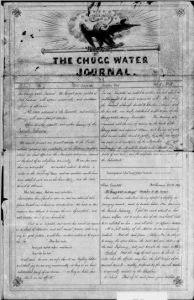 said to describe the noise that the buffalo or the falling chalk made when it hit the ground or fell into the water under the bluff, depending on which version of the legend you wish to believe. Because of that, the Indians began to call the area “water at the place where the buffalo chug.” The White Man adopted the Indian name and called the area “Chug Springs.” Chugwater Creek was named after Chug Springs, and from that came the name of Chugwater. Still, the reason for the name of the paper is speculation on my part. I am assuming that it was in an effort to remain more or less purist about the name, and since Chug Springs came first, that might be reason the paper was named the Chugg Water Journal.
said to describe the noise that the buffalo or the falling chalk made when it hit the ground or fell into the water under the bluff, depending on which version of the legend you wish to believe. Because of that, the Indians began to call the area “water at the place where the buffalo chug.” The White Man adopted the Indian name and called the area “Chug Springs.” Chugwater Creek was named after Chug Springs, and from that came the name of Chugwater. Still, the reason for the name of the paper is speculation on my part. I am assuming that it was in an effort to remain more or less purist about the name, and since Chug Springs came first, that might be reason the paper was named the Chugg Water Journal.
Aside from the name of the paper, I was very interested in the fact that it was hand written…at least at first. Of course, I knew that many newspapers were hand written at first, because there was no such thing as a printing press, or even typewriters for a long time, but to be able to actually view a handwritten newspaper was very exciting to me. My inquisitive mind embarked on a different thought journey. If the newspaper were hand written, and the 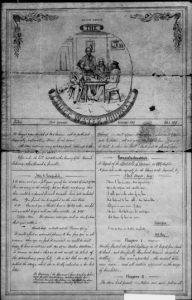 town had 50 families in it, all of whom wanted a paper, how long would it take to write all those papers up? And was it the same person doing it? Wow!! After a time, you would know the news by heart, and it would become seriously old news. Then, when you consider the fact that the paper was to “appear occasionally and sometimes oftener, if not sooner”…whatever that actually meant, the news became really old.
town had 50 families in it, all of whom wanted a paper, how long would it take to write all those papers up? And was it the same person doing it? Wow!! After a time, you would know the news by heart, and it would become seriously old news. Then, when you consider the fact that the paper was to “appear occasionally and sometimes oftener, if not sooner”…whatever that actually meant, the news became really old.
Still, the paper and its possible contents intrigued me. I started thinking about different dates and events in Wyoming’s history that might have appeared in that and other Wyoming newspapers. Would a first-hand account be more accurate that the history books? Even if history’s account is accurate, the newspapers would provide the feelings of the writer, and that is pure gold, because that makes it personal. I found myself feeling very excited about my future visits to this and other old and handwritten newspaper sites. I know that I will find many treasures.

